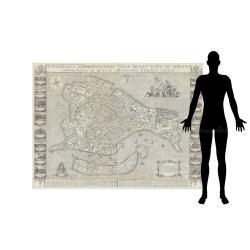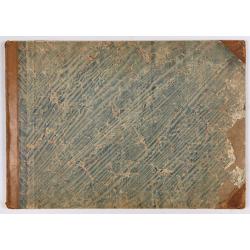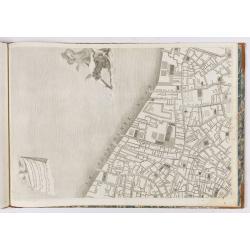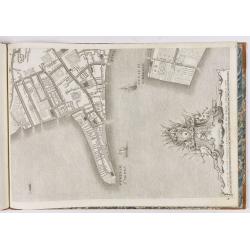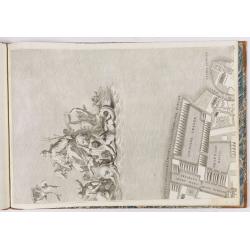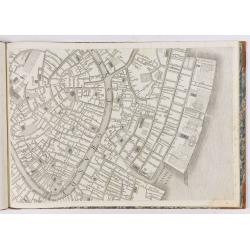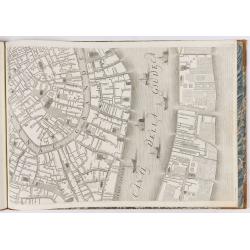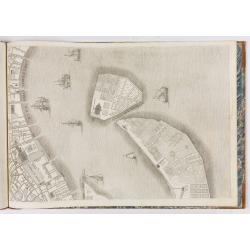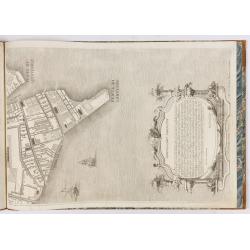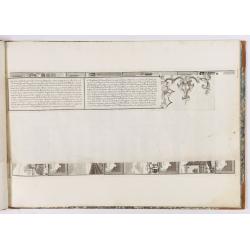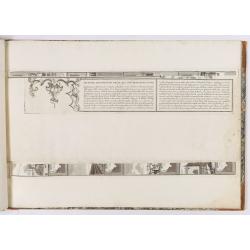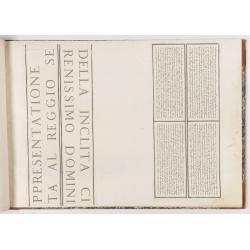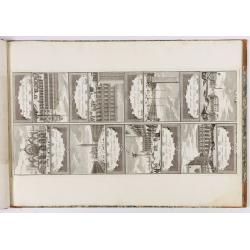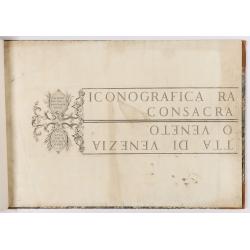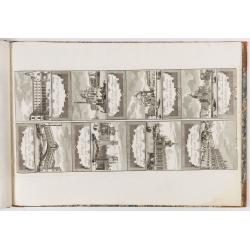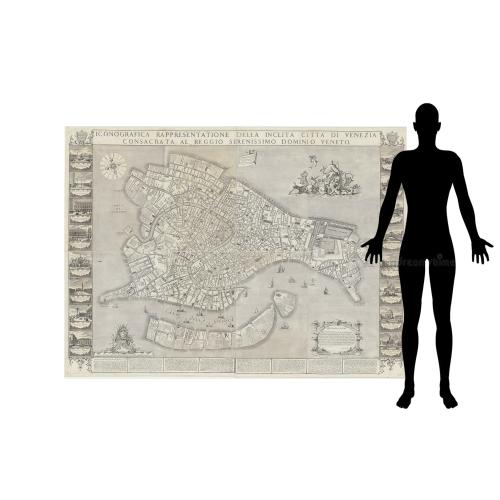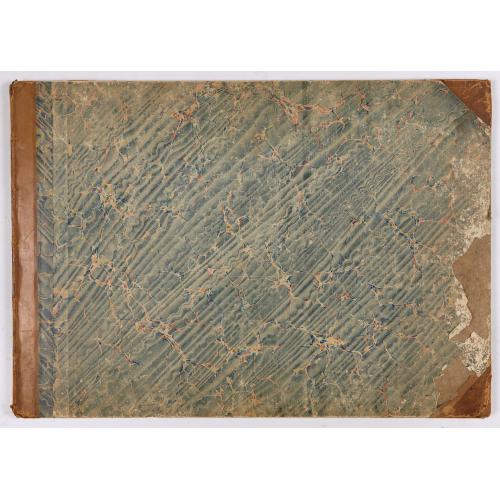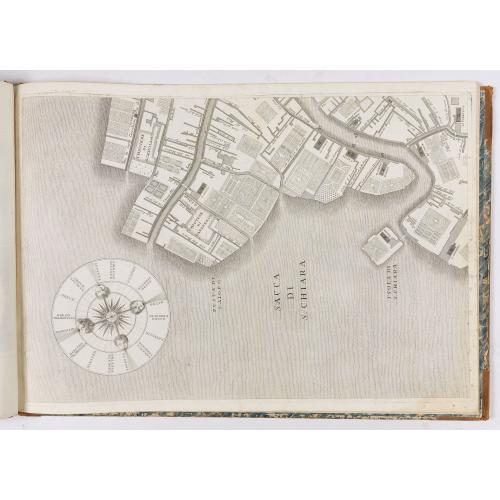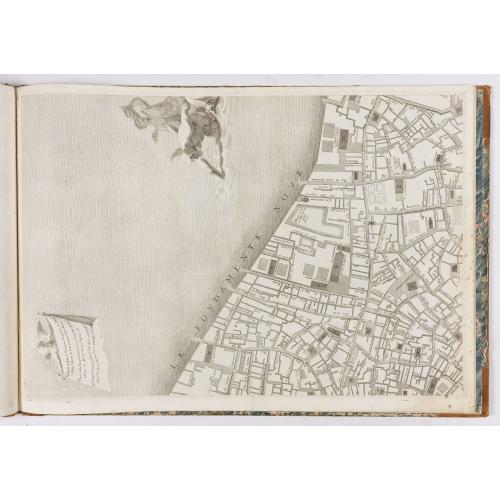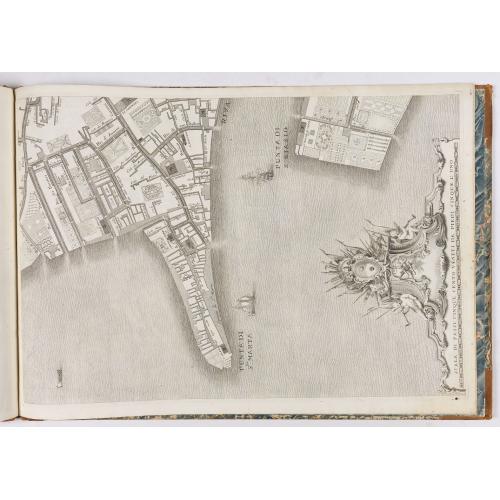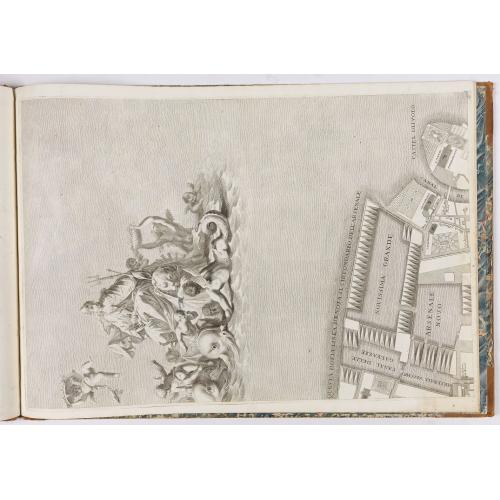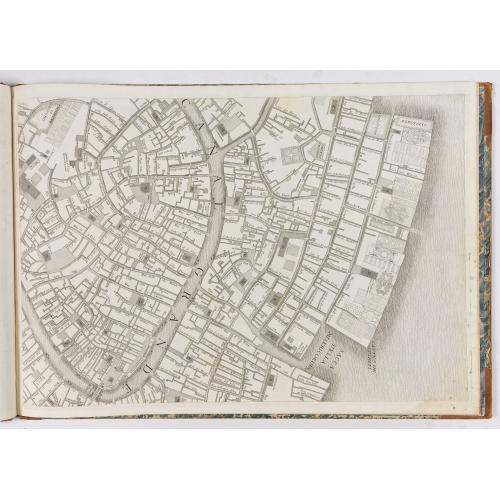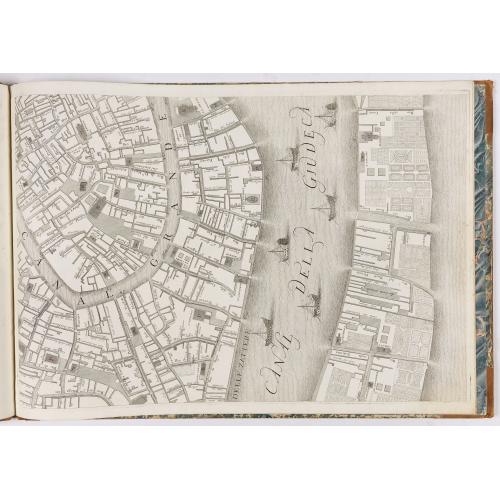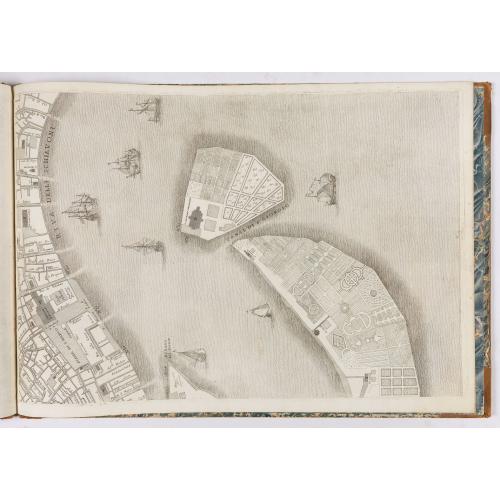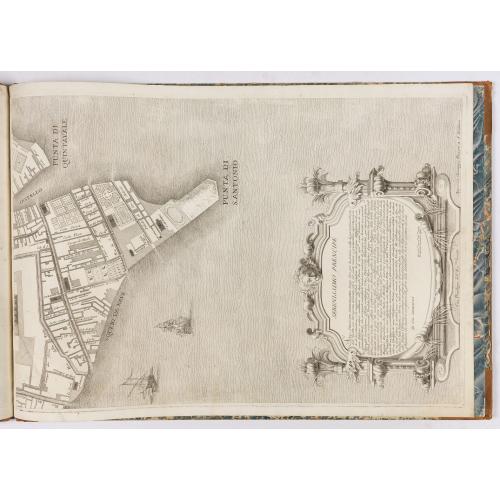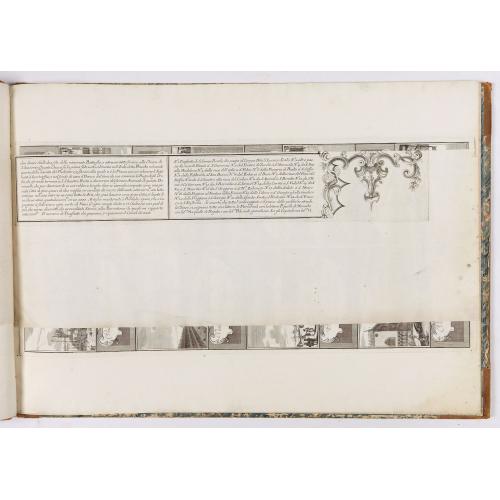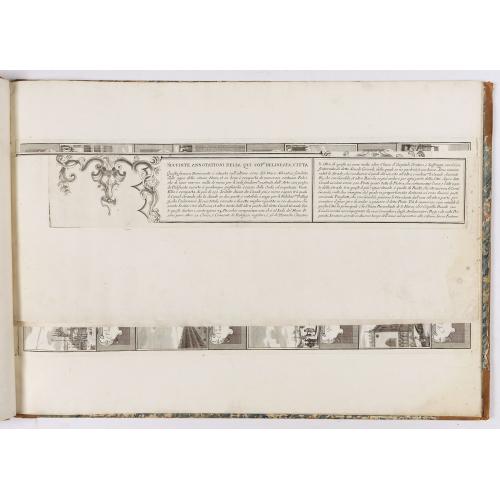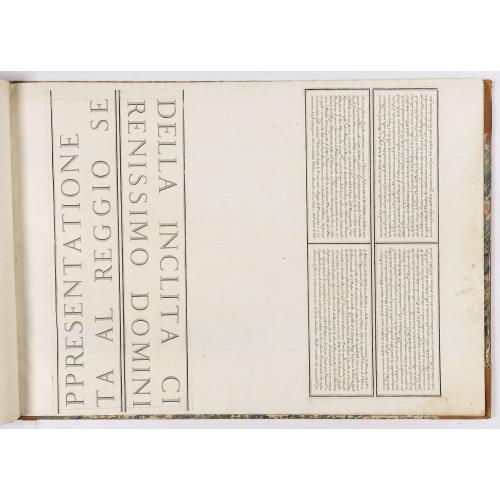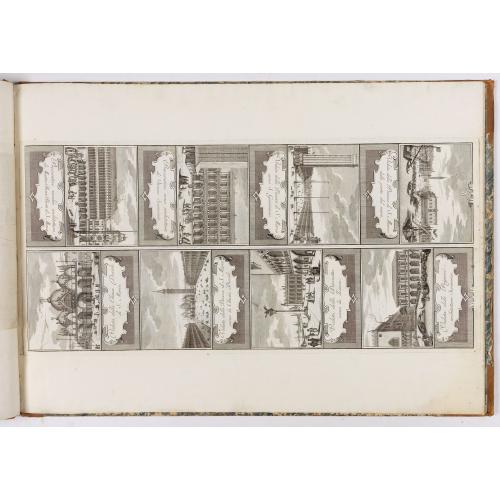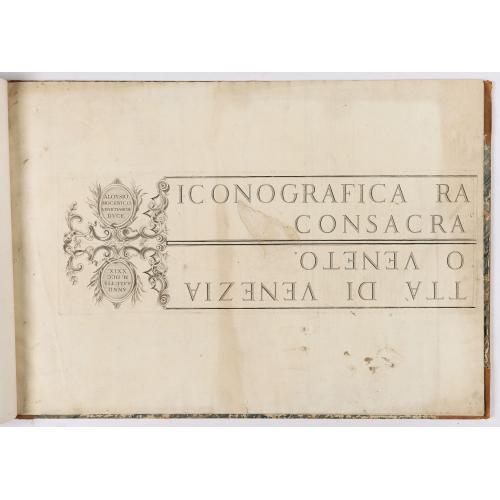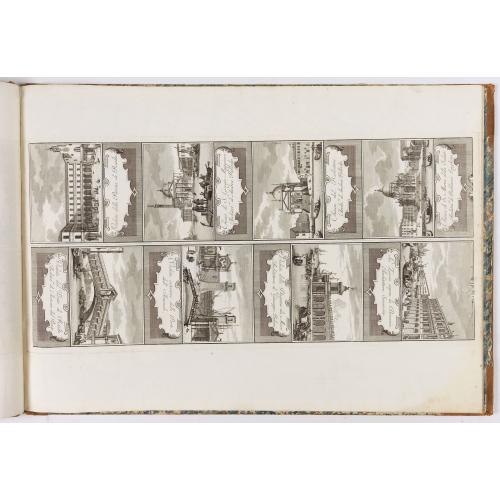Description
Spanning more than two meters (nearly 7 feet) in width, it was engraved by Francesco Zucchi after Luca Carlevarijs (1663-1730).
Uncut and bound engraved wall map, with additional panels bearing the running title at head and side panels containing 16 views of prominent buildings (engravings attributed to Francesco Zucchi, after Luca Carlevarij's 'Fabriche e Vedute di Venetia', 1703), coat-of-arms surrounded by putti and military equipment of Francesco Morosini (1619-1694, last of the 'warrior Doges').
NOTE : the image with the human figure is a digital compilation of the separate parts. The map is uncut and bound large oblong folio boards covered with marbled paper (485 x 685 mm).
During the period when the Ughi map was created, Venice had maintained its independence as a republic for nearly a millennium. Throughout much of this history, Venice stood as a dominant force in the Mediterranean, serving as a critical crossroads between the East and West. It was renowned as the wealthiest and most prosperous commercial center in the civilized world.
Rarity
Furlanetto continued to print the map for at least six decades, with his name replacing Baroni's in the lower right corner.
The Ughi map was intended to be hung on a wall mounted on linen. A map hanging on a wall will not survive this condition for long unless stored and handled in the gentlest way possible. The fastenings tear, the glue between the paper and the support fails, and the materials become brittle and damaged by the environment, insects, handling, and rolled storage. Thus, only a few copies of this monumental wall map of Venice have survived.
We have traced only one other example of the first issue with the signature of Giuseppe Baroni : Library of Congress Online Catalog (1,611,798). This example is preserved without vignettes and text.
This item is the only known example of the first issue, complete with vignettes and text and the signature of Giuseppe Baroni. This item was previously owned by the collector Charles Filippi, whose prestigious library was auctioned in France in 1994.
Examples of later issues by Lodovico Forlanetto (1739) are found in the trade and the following libraries and public collections: Bibliothèque Nationale de France; Houghton Library, Harvard; Library of Congress, Washington, D.C. (without borders); Zentralbibliothek Zurich (without borders); Leiden University Library; Sächsische Landesbibliothek, Dresden; Museo Correr, Venice; The Royal Collection, London; Biblioteca Nazionale Centrale, Florence; Biblioteca Nazionale Marciana, Venice.
At Sotheby's in London, one example sold for GBP 16,250 in 2009 (Sale L09774) and another for GBP 12,500 in 2017 (Sale L17401).
Christie's in London (sale 7164) in 2005 for GBP 8,500 without side banners, and another example at Christie's (1998 sale 6111, also without the 16 views) sold at GBP 12,075.
At the bottom left, near the Morosini shield, putti are depicted holding flags, pikes, and staffs, symbolizing triumphant war-related elements. This references Francesco Morosini, the last warrior, Doge, who led the Venetians in their battle against the Turks during the War for Candia or Crete. After 465 years of Venetian occupation, Candia was lost to the Turks in 1669. The siege of Candia, lasting twenty-two years, marked a significant event in the history of Venice as it stood alone in defending the city against Turkish incursions into Western Europe.
At the top right is the depiction of an allegorical Venice, triumphantly sailing on the sea pulled by dolphins, sea animals, and divinities, with the lion of St. Mark at her feet, symbolizing her marriage to the Queen of the sea and the riches she derives from it. St. Mark is the patron saint of Venice.
At the top left of the map, is the Vitruvian windrose, each wind direction personified by the head of a putti, and the eight major points of the compass, important for a city dependent on seafaring trade.
At the bottom left, around the shield of the Morosini, are seen putti holding flags, pikes, and staffs - triumphal war articles. Francesco Morosini, the last of the warrior Doges, led the battle against the Turks in the War for Candia or Crete which was lost to the Venetians after 465 years of occupation in 1669. This symbol would not have been lost on Europeans of the time. The siege of Candia lasted for twenty-two years in which the Venetians, though occasionally aided by European allies, stood alone in the defence of the town and the encroachment of the Turks into Western Europe.
Provenance :
The item belonged to the collector Charles Filippi, whose prestigious library was auctioned in Paris in 1994 by Etienne Ader & Jacques Tajan, Hôtel George V."l'Italie de Pétrarque à Stendhal".
Lodovico Ughi, the author or dedicator of the map, remains a somewhat elusive historical figure with limited information about his life and background. Some sources have suggested that Ughi hailed from Bologna or Ferrara, although these details remain unverified. However, what has endured through history is his enduring legacy as the creator of the 1729 wall map, which stands as an epochal and definitive representation of Venice.
The Ughi map marks a significant shift in Venetian cartography as Venice's first and largest topographical map based on meticulous field surveys rather than the observation and replication of existing maps. It was republished twice during the century and remained the foundational reference for all subsequent topographical representations of Venice until the Republic's downfall in 1797.
The first publisher of the map, Giuseppe Baroni, was one of a group of six Venetian printmakers and merchants who in 1718 formed a guild of engravers called L'Arte degli Incisori.
Upon Baroni's passing, records indicate that the copper plates used for the Ughi map were among the assets listed in his workshop's inventory. Lodovico Furlanetto, the second map publisher, acquired these plates when he purchased the entire inventory from Baroni's estate. Furlanetto continued to print the map for at least six decades, with his own name replacing Baroni's in the lower right corner.
Recent studies have yielded a significant discovery related to the Ughi map. An exquisite drawing titled Venezia Trionfonte, attributed to the esteemed Venetian painter Sebastiano Ricci (1659-1734), has come to light. This drawing can now be firmly established as the preparatory artwork for the allegorical figures positioned in the upper right portion of the Ughi map.
The Importance of the Ughi Map as a Cartographic Document and as a Work of Art
Traditionally, Venetian mapmakers replicated each other's work, resulting in minimal alterations to the city's visual representation over the centuries. However, there were two notable exceptions : Jacopo de Barbari's remarkable bird's-eye view of Venice, printed in 1500, and Ughi's map from 1729. These two maps not only hold the distinction of being the largest printed maps of Venice but also served as enduring models for all subsequent depictions of the city.
De Barbari's bird's-eye view provided a unique perspective, capturing the city from a high oblique angle. This allowed cartographers to convey the vertical dimensions of buildings and architectural features while maintaining a horizontal perspective through the clever use of perspective rather than adhering strictly to true scale. The primary aim was to impress the viewer with its artistic prowess.
As the eighteenth century ushered in advancements in science and technology, urban cartographers adopted more accurate and functional surveying and measuring techniques. By the 1730s, bird's-eye views no longer met the standards of accuracy demanded by urban surveyors. Instead, they turned to the topographical map - a less ornate but more precise ground plan.
The Ughi map marks a significant shift in Venetian cartography as the first and largest topographical map of Venice based on meticulous field surveys rather than the observation and replication of existing maps. It was republished twice more during the century and remained the foundational reference for all subsequent topographical representations of Venice until the Republic's downfall in 1797. Through various copies and adaptations, it continued to dominate Venetian mapmaking well into the nineteenth century.
Iconography and Printed Information on The Ughi Map
The inclusion of images on maps holds profound significance, as it not only conveys geographical information but also provides a visual narrative of a city's grandeur, wealth, and multifaceted greatness, encompassing political, commercial, and military aspects.
During the period when the Ughi map was created, Venice had maintained its independence as a republic for nearly a millennium. Throughout much of this history, Venice stood as a dominant force in the Mediterranean, serving as a critical crossroads between the East and West. It was renowned as the wealthiest and most prosperous commercial center in the civilized world.
This historical context, as eloquently put by Jan Morris, reflects Venice's remarkable confidence in its endurance, coupled with its flair for ceremony and effective self-promotion.
The Ughi map, in essence, serves as an advertisement for the city of Venice, accentuating its beauty, military prowess, and prosperity. Even the title of the map, "Iconografica Reppresentazione della Inclita Citta di Venezia al Reggio Serenissimo Domino Veneto" (Topographical Representation of the Glorious City of Venice Consecrated in the Reign of the Most Serene Veneto Domaine), underscores its promotional intent. Surrounding the map portion, sixteen exquisite views of Venice are featured, compensating for the absence of the renowned landmarks, attractions, and fortification depictions characteristic of bird's-eye view maps. These views collectively convey Venice's allure, affluence, and military strength.
At the bottom left, near the Morosini shield, putti are depicted holding flags, pikes, and staffs, symbolizing triumphant war-related elements. This references Francesco Morosini, the last warrior, Doge, who led the Venetians in their battle against the Turks during the War for Candia or Crete. After 465 years of Venetian occupation, Candia was lost to the Turks in 1669.
The siege of Candia, lasting twenty-two years, marked a significant event in the history of Venice as it stood alone in defending the city against Turkish incursions into Western Europe.
The top right of the map features an allegorical representation of Venice, symbolically sailing on the sea, pulled by dolphins, sea creatures, and divinities. The presence of the lion of St. Mark at her feet signifies Venice's union with the Queen of the Sea and the wealth derived from maritime endeavors. St. Mark, Venice's patron saint, further underscores this naval connection.
In the top left corner, a wind rose is depicted, with each wind direction personified by the head of a putti. The eight major compass points hold particular importance for a city reliant on seafaring trade.
Within the cartouche at the bottom right, there is a dedication by Lodovico Ughi to Alvise Mocenigo, the Doge in 1729. Ughi extols Venice as a "glorious city," blessed by the Virgin, a divine entity, the Queen of the Adriatic, globally recognized for its justice, feared by its adversaries, and defended by its dedicated sons who have sacrificed their lives. This dedication captures the deep reverence and loyalty to Venice during that era.
Notably, due to the map's large scale, place names are directly incorporated onto the map itself, eliminating the need for reference letters or numbers correlating to a separate text. To differentiate urban elements, streets are depicted with parallel lines, religious buildings feature closer parallel lines and letters, and the rios and canals are represented by wavy lines. Civic buildings are left in white, ensuring clarity and readability.
The Work of Art
The introduction of the printing press marked a significant development in cartography, and the Venetians were quick to harness this technology for map production. Venice, a bustling mercantile hub, received a steady stream of cartographic information from various corners of the world. The maps they produced served the needs of Venetian outposts and catered to the demands of travelers, scholars, and individuals in positions of governance and military authority. By the eighteenth century, Venice had cultivated the ideal conditions for a flourishing printmaking market. Skilled engravers and book illustrators were highly active, generating a prolific output of prints. Prints were easily transportable, manageable, and exportable, making them a sought-after commodity.
The printed Ughi map held profound importance within eighteenth-century Venetian culture.
The publishers, engravers, and artists involved in its creation represented some of their era's most talented and productive figures.
The initial publisher of the map, Giuseppe Baroni, was part of a group of six Venetian printmakers and merchants who established a guild of engravers called L'Arte degli Incisori in 1718. This guild aimed to regulate the quality of copper engraving as an art form and sought exclusive rights to its production. Baroni's workshop, or Bottega, was situated in Campo S. Zulian, near Piazza S. Marco, where a significant concentration of printers operated.
While not definitive, stylistic evidence suggests that Francesco Zucchi may have been the engraver responsible for the sixteen views of Venice flanking the Ughi map. Zucchi, a member of Baroni's guild, was a prolific book illustrator. The refined prints of these views were directly adapted from Luca Carlevarij's renowned work Fabriche e Vedute di Venetia, published in 1703. Carlevaris was one of Venice's celebrated vedutisti or view painters.
Recent studies have yielded a significant discovery related to the Ughi map. An exquisite drawing titled Venezia Trionfonte, attributed to the esteemed Venetian painter Sebastiano Ricci (1659-1734), has come to light. This drawing can now be firmly established as the preparatory artwork for the allegorical figures positioned in the upper right portion of the Ughi map. The drawing is housed within album #56, part of the library collection of Anton Maria Zanetti, which is preserved in the Academia Gallery in Venice. Anton Maria Zanetti was not only a friend of Sebastiano Ricci but also a patron of both Sebastiano and Marco Ricci.
This newly identified drawing provides valuable insights into the artistic process and collaborative efforts that contributed to creating the Ughi map. Sebastiano Ricci's Venezia Trionfonte is a critical link between the world of painting and cartography, shedding light on the interconnectedness of artistic disciplines during this period and enhancing our understanding of the map's iconography and cultural significance. Upon Baroni's passing, records indicate that the copper plates used for the Ughi map were among the assets in his workshop's inventory. Lodovico Furlanetto, the second map publisher, acquired these plates when he purchased the entire inventory from Baroni's estate.
Left Side
- Veduta della Chiesa Ducale di S. Marco
- Veduta della Piazza di S. Marco versola Chiesa Ducale
- Veduta della Piazzetta verso la Lecca
- Veduta delle Prigioni architettura Sansovino
- Veduta della Piazza di S. Marco dalla parte del mare
- Veduta della Piazza di S. Marco verso S. Geminiano
- Produrative nove architettura di Vincenzo Scamozzio
- Procurative vecchie architettura di Mastro Bono Proto di S. Marco
Right Side
- Veduta della Piazza di Rialto
- Chiesa di S. Giorgio Maggiore Architet.ra di Andrea Palladio
- Chiesa del Redentore Archi.ra di Andrea Palladio
- Chiesa di S. Maria della Salute Architet.ra di Baldisera Longhena
- La Lecca sopra la Pescaria Architettura Sansovino
- Veduta della Dogana da Mare Architettura di Guiseppe Beloni
- Veduta esteriore delle Porte dell Arsenale
- Veduta del Ponte di Rialto Architet.ra di Antonio dal Ponte
Condition
Half brown leather binding. Boards are covered with marbled paper, spine gilt, and a title label on the spine gilt. Spine and corners are slightly rubbed and worn, and the marbled paper on the first cardboard was partly removed. A few mildew spots affected the plates, the first plate with the title page formerly roughly restored and slightly age-toned. An extremely rare first state of Ughi's Wall Map of Venice published by Giuseppe Baroni. The plan is not assembled; title, text, and vignettes are printed on separate sheets to be cut out; the plan itself consists of 8 sheets.
References
Susan Filter, Historic Intent: Lodovico Ughi's Topographical Map of Venice; A Large Wall Map as an Historic Document, a Work of Art, and a Material Artifact, The Book and Paper Group Annual 13 (1994); Schultz, J.: The Printed Plans and Panoramic Views of Venice (1486-1797), No. 117. Moretto, Gino (ed.). Venetia: le immagini della Reppublica. Padova: Papergraf, 2001; 152.
Learn more about map printing and views of Venice [+]
FAQ - Guarantee - Shipping
Buying in the BuyNow Gallery
This item is available for immediate purchase when a "Add to Cart" or "Inquire Now" button is shown.
Items are sold in the EU margin scheme
Payments are accepted in Euros or US Dollars.
Authenticity Guarantee
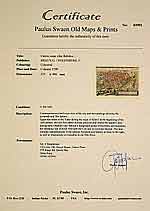 We provide professional descriptions, condition report and HiBCoR rating (based on 45 years experience in the map business)
We provide professional descriptions, condition report and HiBCoR rating (based on 45 years experience in the map business)
We fully guarantee the authenticity of items we sell. We provide a certificate of authenticity for each purchased item.
Condition / Coloring
We indicate the condition of each item and use our unnique HiBCoR grading system in which four key items determine a map's value: Historical Importance, Beauty, Condition/Coloring and Rarity.
We offer many maps in their original black and white condition. We do not systematically color-up maps to make them more sellable to the general public or buyer.
Copper engraved or wood block maps are always hand colored. Maps were initially colored for aesthetic reasons and to improve readability. Nowadays, it is becoming a challenge to find maps in their original colors and are therefor more valuable.
We use the following color keys in our catalog:
Original colors; mean that the colors have been applied around the time the map was issued.
Colored; If the colors are applied recently or at the end of the 20th century, then "colored", or "attractive colors" will be used.
Original o/l colors; means the map has only the borders colored at the time of publication.
Read more about coloring of maps [+]
FAQ
Please have a look for more information about buying in the BuyNow gallery.
Many answers are likely to find in the general help section.
Virtual Collection
![]()
With Virtual Collection you can collect all your favorite items in one place. It is free, and anyone can create his or her Virtual map collection.
Unless you are logged in, the item is only saved for this session. You have to be registed and logged-in if you want to save this item permanently to your Virtual Collection.
Read More [+]
Registering Here, it is and you do not need a credit card.
Add this item to
Virtual Collection
or click the following link to see my Virtual Collection.
Invoice
The invoice and certificates of authenticity are available in the client center >Invoices
| High-Resolution Digital Image Download | |
|
Paulus Swaen maintains an archive of most of our high-resolution rare maps, prints, posters and medieval manuscript scans. We make them freely available for download and study. Read more about free image download |
In accordance with the EU Consumer Rights Directive and habitually reside in the European Union you have the right to cancel the contract for the purchase of a lot, without giving any reason.
The cancellation period will expire 14 calendar days from the day after the date on which you or a third party (other than the carrier and indicated by you) acquires, physical possession of the lot. To exercise the right to cancel you must inform Paulus Swaen Europe bv, which is offering to sell the lot either as an agent for the seller or as the owner of the lot, of your decision to cancel this contract by a clear statement (e.g. a letter sent by post, or e-mail (amsterdam@swaen.com).
To meet the cancellation deadline, it is sufficient for you to send your communication concerning your exercise of the right to cancel before the cancellation period has expired.
